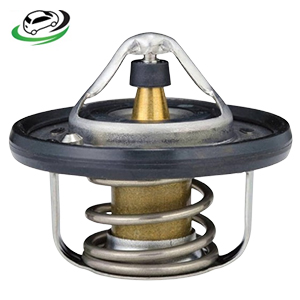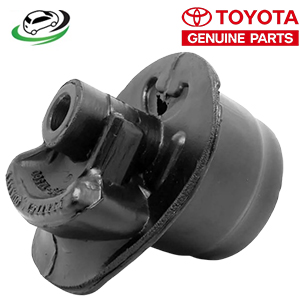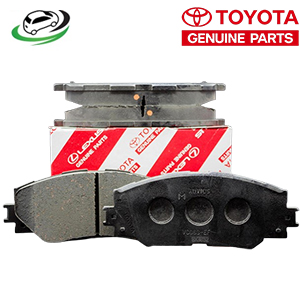-11%
Get Toyota Corolla 2007-2012 Genuine Front Brake Pad Kit 04465YZZR3
The front brake pad kit is an essential component in the braking system of any vehicle. Designed to provide maximum stopping power and ensure safety, brake pads are mounted within the brake calipers and press against the brake rotors when the brake pedal is applied. This friction slows down the wheels, bringing the vehicle to a stop. Genuine front brake pads, specifically designed by the original equipment manufacturer (OEM) for your vehicle, offer superior performance, longevity, and reliability compared to aftermarket options.
Function of Front Brake Pads
Front brake pads play a vital role in converting the kinetic energy of a moving vehicle into thermal energy through friction. This is achieved through the application of hydraulic pressure, where the brake pads press against the rotors. Given that the front wheels bear the most weight during braking, front brake pads typically wear out faster than rear ones. Their function is integral to the overall safety of the vehicle, making the choice of genuine pads critical.
Components of a Genuine Front Brake Pad Kit
A typical genuine front brake pad kit includes several key components:
- Brake Pads: The core component made from high-quality friction material, designed to offer precise stopping power and long life.
- Shims: These are used to reduce noise and vibration. Genuine kits often include anti-squeal shims, providing a quieter braking experience.
- Wear Sensors: These sensors alert the driver when the brake pads have reached their minimum thickness and need replacement.
- Hardware Kit: Includes clips, pins, and other necessary mounting hardware that ensures proper alignment and installation of the brake pads.
- Lubricant: Some kits include brake lubricant to apply on contact points to prevent noise and reduce wear.
Types of Brake Pad Materials
The material used in brake pads is critical to their performance, durability, and feel. Genuine front brake pads are typically made from high-quality materials that provide optimal balance between wear resistance, noise reduction, and stopping power. There are several types of materials used in brake pads, including:
- Ceramic: Ceramic brake pads are made from a dense ceramic compound, often reinforced with copper fibers. They provide excellent stopping power, are quieter, and produce less brake dust. However, they can be more expensive.
- Semi-metallic: These pads contain metal fibers like steel and copper, offering high durability and excellent heat dissipation. They are typically more affordable but tend to be noisier and produce more dust.
- Organic: Made from natural fibers, rubber, and resins, organic pads offer softer braking performance and are quieter. However, they wear out faster and are not ideal for high-performance vehicles.
Benefits of Genuine Front Brake Pads
Opting for a genuine front brake pad kit, designed specifically for your vehicle model, comes with several advantages:
- Superior Fit and Compatibility: Genuine parts are tailored to meet the exact specifications of your vehicle. This ensures a precise fit, preventing potential issues such as uneven wear, brake noise, or vibration.
- Enhanced Safety: Genuine brake pads undergo rigorous testing by the vehicle manufacturer to meet the highest safety standards. They provide reliable stopping power under various driving conditions, ensuring optimal safety for both the driver and passengers.
- Longevity: Since genuine pads are designed specifically for your vehicle, they tend to last longer than aftermarket pads. OEM manufacturers use high-quality materials that are more resistant to wear and tear, offering better value over time.
- Optimal Performance: Genuine brake pads maintain their performance throughout their lifespan, ensuring consistent braking force. This is particularly important in emergency situations where sudden, hard braking is required.
- Minimal Noise and Vibration: OEM brake pads come equipped with anti-noise shims and are designed to reduce brake noise and vibrations. Aftermarket pads may lack these refinements, leading to squealing or grinding sounds during braking.
- Warranty Protection: Many vehicle manufacturers offer a warranty for their genuine parts. By using OEM brake pads, you ensure that your vehicle remains within the warranty terms, protecting you from additional costs.
Maintenance and Care of Front Brake Pads
To ensure that your front brake pads function optimally and last longer, it’s essential to follow certain maintenance and care tips:
- Regular Inspection: Brake pads should be inspected regularly, especially if you hear unusual noises like squealing or grinding. Worn-out brake pads can lead to damage to the rotors, increasing repair costs.
- Brake Fluid Check: The hydraulic system that controls your brakes relies on brake fluid. Ensure the brake fluid level is adequate and that it is free from contamination, as low or dirty fluid can impair braking performance.
- Brake Rotor Maintenance: Brake pads work in tandem with rotors. If the rotors are warped, cracked, or excessively worn, they should be replaced or resurfaced to ensure even wear and smooth braking.
- Smooth Driving: Avoid hard braking when not necessary. Abrupt or aggressive braking can wear out your pads more quickly. Maintaining a steady driving style extends the lifespan of your brake components.
- Brake Pad Wear Sensors: If your vehicle is equipped with wear sensors, pay attention to the warning light on your dashboard. This signal indicates when the brake pads have worn down to the point where they need to be replaced.
Signs of Worn-Out Brake Pads
Recognizing the signs of worn-out brake pads is essential to maintaining your vehicle’s braking performance. Here are some common indicators that your front brake pads may need replacement:
- Squealing or Squeaking Sounds: A high-pitched noise often indicates that the brake pads have worn down and are grinding against the rotors.
- Reduced Braking Performance: If you notice that your vehicle takes longer to stop, it may be a sign that your brake pads are worn out.
- Vibrations in the Brake Pedal: Warped rotors or uneven brake pad wear can cause vibrations when applying the brakes.
- Visible Pad Wear: Some vehicles allow you to visually inspect the brake pads through the wheel. If the pad material appears thin, it’s time for a replacement.
- Brake Warning Light: Many modern vehicles have sensors that trigger a warning light on the dashboard when the brake pads are nearing the end of their life.
Installation of Genuine Front Brake Pads
Installing front brake pads is a precise process that requires the right tools and knowledge. Here’s a basic overview of the steps involved:
- Preparation: Ensure the vehicle is on a flat surface, and use a jack to lift it. Remove the wheels to access the brake components.
- Remove the Old Pads: Unbolt the caliper to expose the brake pads. Remove the old brake pads and shims.
- Install New Pads: Place the new brake pads into the caliper brackets, ensuring they are aligned correctly.
- Reinstall the Caliper: Bolt the caliper back into place, making sure it’s secure.
- Test the Brakes: After installing the pads, press the brake pedal a few times to ensure they are seated properly.
For the best results, it is recommended to have genuine front brake pads installed by a professional mechanic.
Conclusion
Genuine front brake pad kits offer unmatched safety, performance, and durability for your vehicle. By choosing OEM brake pads, you ensure that your car’s braking system remains in optimal condition, providing peace of mind and confidence on the road. Regular maintenance and timely replacement of worn-out brake pads are crucial for your safety and the longevity of your vehicle’s braking components.
Follow us on Facebook for more parts.






Reviews
Clear filtersThere are no reviews yet.